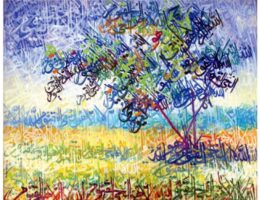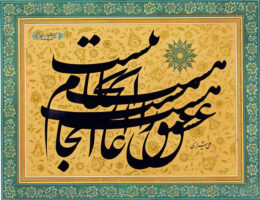IRAN ART EXHIBITION: PERSIAN CALLIGRAPHY FROM KING TAHMURAS TO MIR ALI TABRIZI
According to Iranian legends, calligraphy was invented by Tahmuras, the third king of Pishdadian dynasty. It has been recited in the Book of King (Shahnameh) by Ferdowsi that after the demons were captivated by Tahmuras, they asked for mercy and in return they taught him calligraphy. At the beginning of Islamic Era, the formal alphabet of Iran was a kind of Pahlavi called “Farsi-e Miyaneh” or Middle Persian.
Scientific, literature and political texts were written in Pahlavi and only religious texts were written in Avestan alphabet. After conquest of Iran by the Arab world and their cultural influence, and due to technical shortcomings of Pahlavi alphabet, Pahlavi was replaced by Kufic in many cities of Iran. It was during 14th and 15th centuries that Ta’liq, Nasta’liq and Shekasteh Nasta’liq were developed by the Iranian.
They were enhanced in 16th and 17th centuries and reached perfection in 18th and 19th centuries. Today very few people write in Ta’liq, but Nasta’liq and Shekasteh Nasta’liq are both very common and prominent. In fact, Persian-Islamic calligraphy is one of the flourishing arts mesmerizing both eyes and ears. As if the written words are meet by the eyes, read by the heart and heard by the ears, arousing the two feelings.
It is quiet certain that calligraphy did not reach perfection not in a fraction of a second, but years of practicing, hard work and innovation of many artists have resulted in its high position as a form of art. Calligraphy is categorized as one of fields of Fine Arts. The practitioner, based on the taste of the buyer, may use handmade, marble, plain or colorful papers that are also chosen in appropriate with the text. The finished work can be illuminated too.
This art is mostly used to write copies of holy Quran, book of the poets, or famous sayings of the elder. One of the greatest masters of Nasta’liq who played the most important part in its perfection was Mir Emad from Qazvin. He is considered one of the most celebrated calligraphist of Islamic calligraphy. In addition to Mir Emad, artists such as Mirza Mohammad Hosein Emad ol-Ketab Qazvini, who famously designed “Besmellah (In the name of God) in the form of Tughra bird for the first time), Abd ol-Majid Taleqani and Malek Mohammad Qazvini have all helped for the city of Qazvin to be known as the calligraphy capital of Iran.
History
The evolution of the Persian script can be traced to 500-600 BC to provide inscriptions on monuments built by the Achaemenid kings. Horizontal, vertical, and diagonal nail-shaped letters made up the script called “Khat-e-Mikhi” or “Script of Nails”.
Several centuries later came other scripts like “Pahlavits” and “Avestaee” which involved writing on pages of animal skin with a feather pen. Strangely these scripts had much in common with “Sols” and “Naskh,” Arabic scripts that were invented several centuries later.
Following the spread of Islam in the 7th century, Persians adapted the Arabic alphabet to the Farsi language. The contemporary Farsi alphabet was developed by adding 4 extra characters to the 28 characters of the Arabic alphabet to get 32 Persian (Farsi) letters.
IRAN ART EXHIBITION: Around the 10th century, Ebn-e-Moqlah Beyzavi Shirazi conducted research and studied six major calligraphy styles. He categorized them as “Mohaqqaq,” “Reyhan,” “Sols” or “Thuluth,” “Naskh,” “Reqaa” and “Towqee.”
Then Hassan Farsi Kateb combined “Naskh” and “Reqaa” styles to invent “Taliq,” a new style. It was Mir Ali Tabrizi, master calligrapher, who combined Naskh and Taliq to create “Nas’taliq” – the most attractive style of Persian calligraphy.
“Nas’taliq” is the most popular contemporary Persian calligraphy style that follows natural curves. Greater flexibility in the script led to the invention of “Cursive Nas’taliq” or “Shekasteh Nas’taliq” in the 17th century.
Calligraphy Tools
Paper (Kaaqaz), Calligraphy Pen (Qalam Ney), Pen Sharpener (Qalam-Taraash), Ink (Morakkab), Ink Container (Davaat), Silky Ink-Controller (Liqeh) and Writing Pad (Zir-Dasti) are the tools required for Persian calligraphy. Depending on the required length, Persian calligraphy requires a pen made from reed/cane or bamboo.
Reeds for small to mid-sized pens are sourced from Dezful in Iran and are dried and processed before use. Ink-controlling silk is an important factor in Persian calligraphy as it prevents splashing of ink outside and controls the amount of ink that the calligrapher puts on the pen and places on the paper.

Principles
IRAN ART EXHIBITION: Persian calligraphy has 12 principles which are applied to achieve finesse, balance and beauty in written works.
1. Khat-e-Korsee (Base Line) is a virtual line on which words are rested. The line may be straight horizontal, curved or diagonal.
2. Tarkib (Combination) lays emphasis on the harmony of letters with each other while balancing black and white in the entire effect.
3. Nesbat (Proportion) emphasizes proportion between letters in comparison with each other.
4. Qovvat (strength) and 5. Za’f (Slimness) both represent sturdiness or slimness of the letters or movements wherever applicable.
6. Sath (Flatness) and 7. Dowr (Curvature) indicate the importance of flatness or roundness of the stretched or curved letters or words wherever applicable.
8. So’oud (Descent) and 9. Nozoul (Ascent) are two principles that are applied to determine places where letters or words must be slightly ascending or descending to look more appropriate.
Other principles are summarized as follows:
10. Ossoul (Basics)
11. Safaa (Virtue)
12. Sha’n (Value)
Application
Persian calligraphy was mainly applied to inscriptions at the entrances of mosques, shrines and religious places and for writing religious texts. Nas’taliq and Cursive Nas’taliq, both modern Persian calligraphy styles have also been applied to depict visual illustrations of the depth of Persian poetry. Today, Persian calligraphy finds place in logos, letterheads, visiting cards, banners and posters. The recent development of software packages in calligraphy has made the process of creating art with calligraphy convenient for those who are not very artistically inclined.
Renowned Persian Calligraphers
Mir-Ali Tabrizi invented the most beautiful style of Persian calligraphy which is extremely popular even today is known as the father of Nas-Taliq.
Mir-Emad Hassani, prominent Persian calligrapher is credited with modifying the structure of Nas-Taliq.
IRAN ART EXHIBITION: Mierza Mohammad-Reza Kalhor, tutored Nasser-eddin Shah’s (king of Iran at the time) and though he followed Mir Emad’s style of calligraphy he added his own touch to his works. Emad-ol-Kottab was a royal calligrapher who hand wrote the poet Ferdowsi’s book for Mozaffar-eddin Shah, the then King of Iran.
Soltan-ali Mashadiused his artistic skills to rewrite the works of prominent Persian poets like Hafez, Jaami, and Khaajeh Abdollah Ansaari.
Yaqoot Mosta’sami is believed to have achieved the unique distinction of writing 364 full-versions of the Holy Koran in his own hand.



